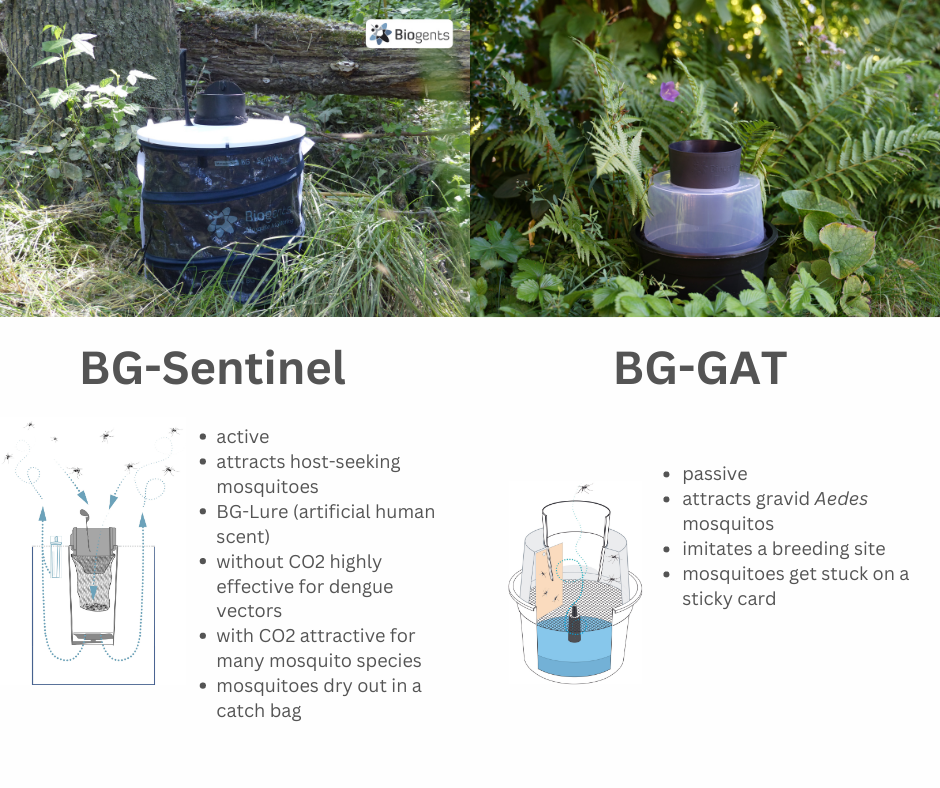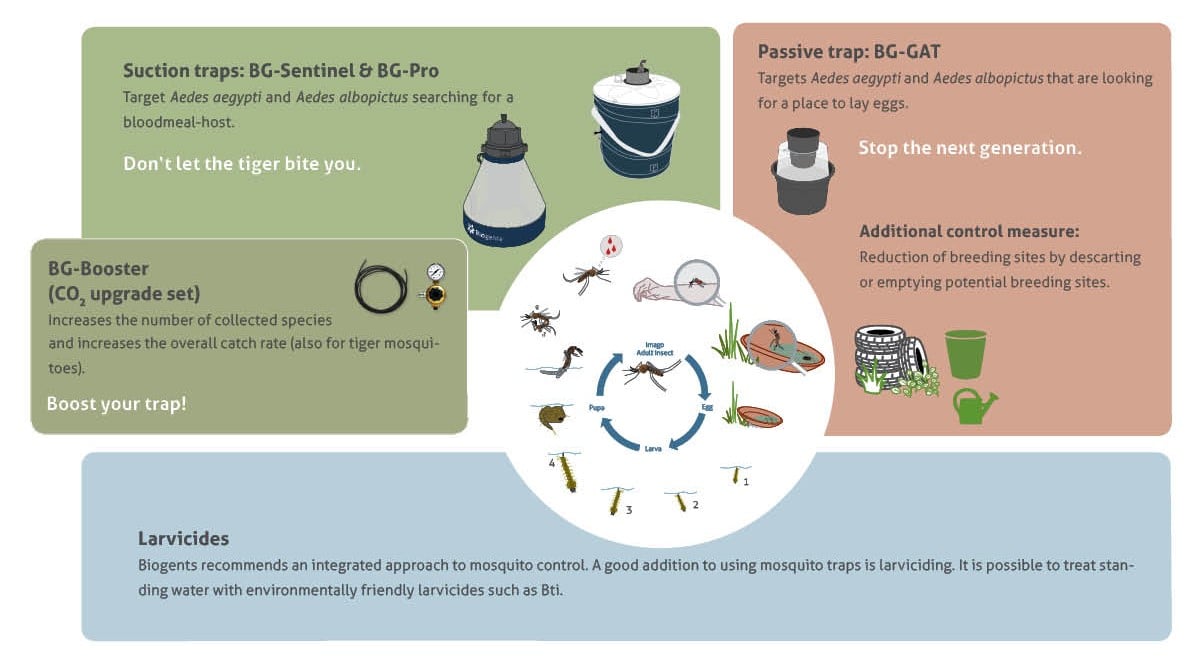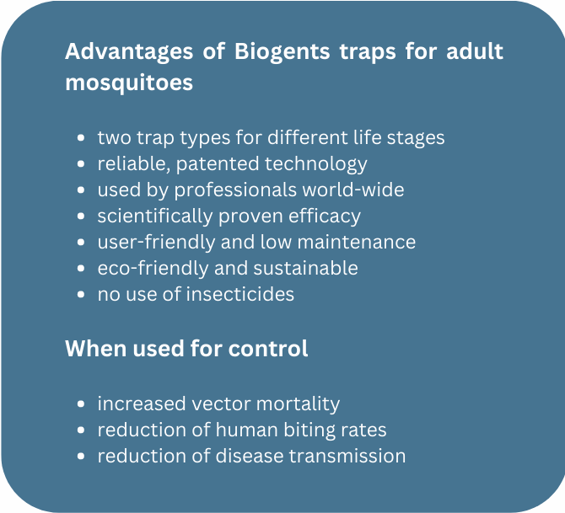This article was originally written for LATAM Plagas, a Latin American magazine about urban plagues. Click here to access the original article (in Spanish; publication date: July 2022).
Aedes aegypti, the main vector for dengue, Zika, chikungunya and yellow fever, has been an unwelcome inhabitant of almost all Latin American countries for centuries. The early stages of monitoring and control in the 1900s aimed at keeping yellow fever outbreaks at bay. Nowadays, dengue is considered the most prevalent threat to public health amongst vector-borne diseases in Latin America. The number of dengue cases are on the rise, outbreaks seem to take longer to control, and a growing number of people is and will be affected.
Thorough surveillance, reliable data and effective control measures are key to successfully keeping Aedes aegypti numbers and consequently the number of dengue cases low. Unfortunately, the past years also brought an array of challenges e.g., limited financial and personnel resources in public health authorities, new health threats like COVID-19, or growing insecticide resistance in mosquitoes.
Therefore, rethinking established routines is crucial to find the best tools for efficient and effective mosquito surveillance and control. This will lead to a better management of Aedes aegypti in the future.
Traditional Stegomyia Indices – old, but are they good?
The traditional larval indices (a.k.a. Stegomyia Indices) that were established as a tool to measure the effect of yellow fever control efforts on Ae. aegypti populations date back to 1923. The public health problem behind the larval indices has in the meantime shifted from yellow fever to dengue, chikungunya, and Zika. Now, a hundred years after their first description, larval indices are still widely used in developing countries. But are they a good tool for estimating disease transmission risks and effects of vector control efforts?
It depends. They can give some insight on preferred breeding sites of local vector populations and tell something about the effect of control measures that only target breeding sites. However, many studies have demonstrated that larval indices do not correlate with dengue transmission risk, which is due to several problems of the method itself and operational challenges:
- Immatures are often not counted, and the productivity of positive containers is unknown and not considered
- Access to houses is often denied
- Results depend highly on the health workers’ motivation and skill to find breeding sites
- High time consumption per surveyed household and high associated costs
- Due to high labor, only a limited number of larval surveys possible per year (-> low temporal resolution, e.g., usually three surveys per year)
It is not surprising, that in the last 25 years, larval indices have been questioned and increasingly seen as an inappropriate measure for monitoring dengue mosquitoes. Nevertheless, many countries still conduct these surveys, often following the vector surveillance guidelines of their countries.
Traps are the better alternative!
Mosquito traps have been increasingly used for monitoring dengue vectors. One classic model, the patent-free low-cost ovitrap has been in use for monitoring Aedes aegypti since 1965. They are more sensitive than larval surveys, but it remains difficult to estimate adult mosquito abundance and dengue transmission risks from ovitrap indices, as it is not known, by how many mosquitoes the eggs inside an ovitrap were deposited. Furthermore, to identify the mosquito species of the eggs (Ae. aegypti or Ae. albopictus), they need to hatch into larvae – which takes a lab structure and time. Nonetheless, ovitraps are good indicators for the presence or absence of dengue vectors.
Traps for adult mosquitoes provide better information for decision making regarding mosquito control actions. This is due to their many advantages over larval surveys:
- Direct measurement of the abundance of adult female dengue vectors, and therefore much higher correlation with dengue risk
- Better acceptance of householders, as traps are far less intrusive than having the whole premise searched for breeding sites
- One health worker can visit the traps of many households per day
- High spatial resolution is possible (a high number of monitored households per area)
- High temporal resolution
High temporal resolution, e.g. weekly or bi-weekly monitoring, leads to a continuous estimation of adult Aedes infestation. This allows local health authorities to react more promptly to changes in mosquito density. Higher spatial resolution results in detecting hotspots of Aedes infestation easier and direct control measures specifically to those areas that need them the most.
Traps for adult dengue vectors have been successfully used in some Brazilian cities for routine city-wide monitoring. In these studies, Ae. aegypti trapping data from two different adult trap types correlated with the risk of Dengue cases (Ferreira et al. 2017, Parra et. al 2018). The study that used BG-Sentinel traps showed that operational costs for using BG-Sentinel traps were 71 % lower in comparison to performing larval surveys. In another study from Brazil, the authors calculated a 83% lower cost of an entomological survey, when using Biogents traps instead of determining the Breteau Index for the same area (Parra et al., 2022).
Reliable surveillance – effective control: how to do it?
There are several mosquito traps available on the market, but only a hand full have been used by mosquito scientists and health authorities. Biogents’ intensive research on mosquitoes’ host finding behaviour and the goal to develop better mosquito control methods cumulated in a highly efficient mosquito trap: the BG-Sentinel. Since its launch in 2004 it has become the gold-standard for monitoring Aedes mosquitoes and is also a recommended trap by the CDC and ECDC. This trap has been successfully used for catching other mosquito species all over the world to answer a high variety of research questions and has also been used for mosquito control.
The BG-Pro is a new modular trap for professionals and is ideal to collect all types of mosquitoes. It was developed to offer the functions of the most widely used monitoring traps in one product while providing Biogents patented technology. Field tests show excellent results indicating that the BG-Pro is at least as good as the CDC and the BG-Sentinel traps (Degener et al. 2021).
The BG-GAT (Gravid Aedes Trap) that targets egg laying mosquitoes, has also been increasingly used by mosquito scientists and health authorities for monitoring and control of tiger mosquitoes. Other than the BG-Sentinel and the BG-Pro, this is a passive trap that does not require energy.
BG-Sentinel/BG-Pro and BG-GAT – what’s the difference?
The BG-Sentinel and the BG-Pro are active suction traps that imitate human beings. Upwards directed air flows imitate the convection currents of a human body and dispense a patented artificial human scent (BG-Lure) which enhances the attractiveness of the trap. Central air currents generated by the ventilator draw the mosquitoes in. A light-dark contrast acts as a visual cue. Once captured in a catch bag, the mosquitoes dry out.
The BG-Sentinel and the BG-Pro are highly attractive for host-seeking dengue mosquitoes (Ae. aegypti), Asian tiger mosquitoes (Ae. albopictus), and Southern house mosquitoes (Culex quinquefasciatus). Carbon dioxide can optionally be added, which usually increases catch rates of Ae. albopictus and Cx. quinquefasciatus by about 5-fold, and makes the trap attractive for a high variety of mosquito species.
For monitoring, suction traps trap typically remain 24 hours on their position. For mosquito control, the traps are used 24/7 during the season.
The BG-GAT trap (Gravid Aedes Trap) is an affordable, passive trap that has all characteristics of an ideal breeding site for gravid Ae. aegypti and Ae. albopictus. The mosquitoes enter the transparent chamber through the black funnel. Once inside, mosquitoes try to escape through the translucent chamber where they are captured on the surface of the sticky card and die. The mosquitoes on the sticky cards should be counted and identified either weekly or every two weeks.
The BG-GAT is highly sensitive for detecting the presence of container breeders like Ae. aegypti and Ae. albopictus, and therefore a good alternative to ovitraps.
Since the BG-GAT has lower catch rates than the BG-Sentinel or the BG-Pro, the trap usually remains constantly at its location.
All Biogents traps are environmentally friendly. They don’t use any toxic products to kill the mosquitoes. In the BG-Sentinel and the BG-Pro, mosquitoes dry out in the catch bag and in the BG-GAT, mosquitoes get stuck on a sticky card.

How can Biogents mosquito traps support public health efforts?
Monitoring: traps only or as an addition to larval surveys
Both traps are an excellent choice for city-wide monitoring efforts. To get the best insight of your local mosquito population, the best option is to use the BG-GAT and the BG-Sentinel or BG-Pro in combination.
Placing BG-GAT traps in areas with low dengue mosquito abundance, or at places, where their presence has not been identified yet, helps to detect new infestations very early.
With BG-GAT traps distributed evenly in urban settings of known dengue vector presence, it is possible to obtain mosquito monitoring data every two weeks throughout the year. Such high temporal resolution will support early detection of mosquito hotspots that might result in disease outbreaks and allows you to determine the predominant species (Ae. aegypti or Ae. albopictus).
The suction traps BG-Pro and BG-Sentinel, with their high catch rates are reliable allies for monitoring all mosquito species and scanning for other potential disease vectors, when you operate them with CO2. Without addition of CO2, they catch predominantly dengue- and house mosquitoes. These traps is especially useful in strategic locations such as airports, ports, schools, or hospitals, where the introduction of mosquitoes, and virus circulation is likely to occur.
Control with Biogents traps: an increasingly explored approach
Due to the often cryptic nature of breeding sites, it is almost impossible to eliminate or treat them all. Targeting adult mosquitoes is therefore important for successful mosquito control. Conventional adult mosquito control measures are inefficient due to operational constraints and insecticide resistances. The idea of using traps is to constantly remove adult mosquitoes from the environment. As the Biogents suction traps (BG-Pro and BG-Sentinel) and the BG-GAT target dengue mosquitoes of different life stages, it is best, to use both traps combined in mass trapping programs.
A recent example in which Biogents suction traps and BG-GAT traps were successfully used for mosquito control comes from an island of the Maldives that was heavily infested by Cx. quinquefasciatus and Ae. albopictus (Jahir et al. 2022). Many years of extensive insecticide use made the local mosquito population insecticide resistant. The local flora and fauna were also strongly negatively affected. The constant use of Biogents suction traps and BG-GAT traps, together with breeding site removal, proved successful in reducing the local mosquito population. As insecticides are not sprayed anymore, the local fauna and flora are beginning to recover as well.
In the USA, several citizen science programs have been established, in which Biogents traps are used for the control of Ae. albopictus. The results of one of these projects, that used BG-GAT traps, were published in the scientific journal “nature scientific reports” (Johnson et al. 2018).

Vector monitoring and control – a never ending story
History shows that public and private efforts are needed to monitor and control vectors like Aedes aegypti. New methods and scientifically proven products, such as adult mosquito surveys and traps for control, should complement the existing toolbox. This would also support working towards a more efficient and resource-oriented approach in vector control, as suggested by the Integrated Management Strategy for Dengue Prevention and Control in the Region of the Americas (PAHO/WHO 2018).

Share this article:






